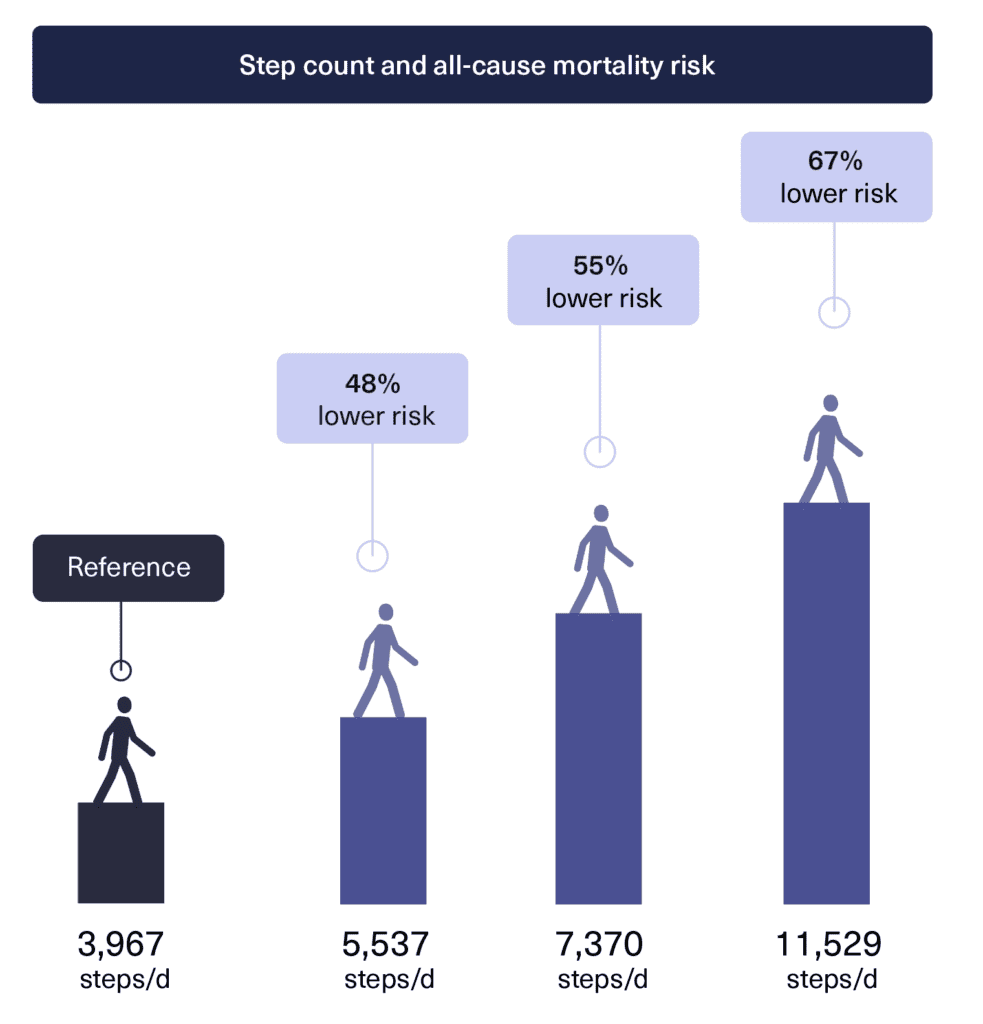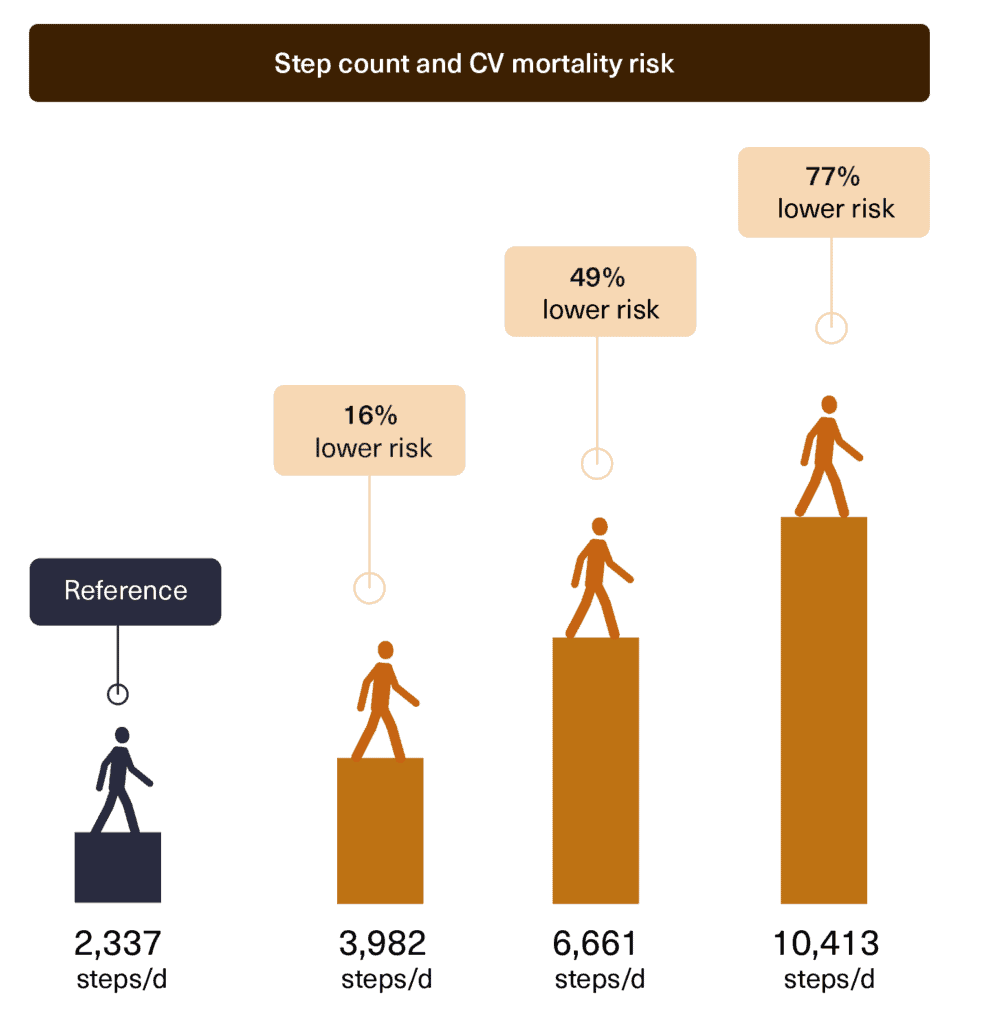In a world filled with fitness trackers and step-counting apps, the magic number of 10,000 steps per day is firmly lodged in all our psyches. But you probably don’t need to dedicate your life to walking to live a longer, healthier life.
I’ve previously written that you likely don’t need to walk 10,000 steps per day to see positive health improvements, and most of the research suggests that, after a point, the cost-benefit ratio of walking isn’t linear.
In other words, someone who increases their daily steps from, say, ~2000 per day to ~7000 per day will see a bigger health benefit than someone increasing their steps from ~10,000 to ~15,000 per day.
However, research on this topic is always evolving, and new studies are published that could and, where appropriate, should change what we previously believed.
To that end, a new meta-analysis was just published that revisited the relationship between step count and mortality risk. 1
First, we’ll look at what this new study found. Then, we’ll discuss what matters more than just your step count. And we’ll wrap things up with some guidelines on how much activity you need to do to maximise your health.
What did the researchers do?
The researchers investigated the relationship between step count and all-cause and cardiovascular (CV) mortality.
Additionally, they were curious to see if a person’s age, sex, or the climate they lived in (i.e. a cold or warm region) changed the relationship between step count and the risk of death.
17 studies were included in the final analysis, which totalled ~227,000 individuals (mean age was 64 years and ~50% were females) who were followed for a median of ~7 years.
What did they find?
For every additional 1000 steps someone walked, the risk of death was reduced by 15%, while every 500 additional steps reduced the risk of CV mortality by 7%.
When looking at the average daily steps in comparison with the reference step count (3967 steps) for all-cause mortality:
- Those who took around 5,537 steps had a 48% lower risk (of all-cause mortality)
- Those who took around 7,370 steps had a 55% lower risk.
- Those who took around 11,529 steps had a 67% lower risk.

Similarly, compared with the reference step count for CV mortality (2337 steps):
- Those who took around 3,982 steps had a 16% lower risk.
- Those who took around 6,661 steps had a 49% lower risk.
- Those who took around 10,413 steps had a 77% lower risk.

An increase in steps led to a decrease in the risk of death regardless of sex or climate.
However, when researchers compared those under 60 to those over 60, they found that older individuals saw the biggest benefit between ~6000-10,000 steps per day (42.3% risk reduction), and younger individuals saw the biggest benefit between 7000-13,000 steps per day (49% risk reduction).
This new study’s findings are somewhat in line with the previous meta-analysis by Paluch and colleagues, which suggested there was a progressive decrease in mortality risk, plateauing around 6,000-8,000 steps for adults aged 60 years and over and 8,000-10,000 steps per day for adults younger than 60 years.
However, the current study found the more steps taken, the greater the health benefits, without an apparent plateau. Though, the researchers cautioned this observation needs further validation, especially since studies focusing on step counts as high as 20,000 per day are limited.
We now have two pretty comprehensive meta-analyses that show a similar trend: The most significant health benefits of walking tend to occur somewhere between 6,000-10,000 steps for older adults and 7,000-13,000 steps for younger adults.
While walking more than this might offer some additional benefits, it’s going to require a pretty big time investment for a marginal gain in health improvements.
But with all of this talk of step counts, it’s easy to forget two important points:
- In research like this, steps are effectively a proxy for total activity levels.
- Most people reading this don’t solely rely on walking for their physical activity. Most of you lift weights, you probably do some form of ‘formal’ cardio like running, and maybe you play a sport a few times per week. All of these things contribute to reducing the risk of death and disease.
So, in reality, what studies like this are showing is reducing the time you’re sedentary will likely confer a number of positive health benefits.
And on that note…
The real key: reducing sedentary time
Way back in 2019, I wrote an article pushing back against the idea that sitting was killing us. I referenced a number of studies showing it’s not sitting that’s the problem but too much sedentary time.
For instance, I cited a 2016 paper that analysed data from more than 1 million people and found 60 to 75 minutes of moderately intense physical activity per day countered the effects of too much sitting. 2
If you take a look at the image below (taken from that study), you can see that individuals with higher levels of activity (based on METs–a way to estimate the amount of energy expended during physical activity) had a lower risk of mortality, even if they sat for a large part of the day. To add some context, if you lift weights about three times per week and walk about 7,000 steps per day, that’s roughly 40 MET-h/week.
The same research group published another study a few years later with data from ~850,000 participants that looked at the association between sedentary time and death caused by cardiovascular disease and cancer and whether this differed depending on physical activity levels. 3
They found the risk of death was greater in participants with the lowest levels of physical activity and highest levels of sedentary time (shocking, I know).
Based on their analysis, the researchers noted that about 30-40 minutes of moderate-to-vigorous physical activity (MVPA) per day reduced the risk of death from too much sedentary time. This was an interesting finding since previous research suggested that you’d need 60 to 75 minutes to counteract the effects of prolonged sedentariness. To quote the researchers:
This finding may suggest that relatively low levels of MVPA, lower than the current recommendations, reduces the risk of death if combined with low levels of sedentary time.
Finally, a more recent systematic review and meta-analysis found that physical activity helped reduce or even eliminate the risks associated with sedentary behaviour. 4
Noting that:
Only extremely high levels of prolonged sitting significantly increased the risk of several major non-communicable diseases and all-cause mortality.
Now, this particular study found some evidence that sitting for 30-60 minutes in one go could increase the risk of adverse health outcomes, but this was more of a concern for people not meeting the recommended moderate-to-vigorous physical activity guidelines (more on this in a sec).
In any case, the researchers recommended breaking up a 30-60-minute bout of sitting with some light movement.
So what to make all of this?
The first and most important point is that instead of stressing out about hitting an arbitrary number like 10k steps (which was a marketing ploy, btw), you should be more focused on reducing the amount of time you’re sedentary––and all types of physical activity contribute to reducing the risk of death and disease.
If you’re looking for more concrete numbers, a 2022 study found ~150 to 300 mins/week of vigorous physical activity (VPA) would provide “the nearly maximum association with lower mortality.” 5
Alternatively, if going hard isn’t your thing, 300 to 600 mins/week of moderate physical activity or some combination of the two would provide the same benefits.
But here’s what’s interesting: If you take a look at the image below, you can see once an individual’s getting around ~300 mins of moderate physical activity per week, the dots (representing vigorous physical activity in mins/wk) tend to level off.
In other words, once you’re doing enough moderate physical activity, you aren’t likely to see further benefits from doing additional vigorous physical activity.
It’s not as hard as you think
Fitness ‘gurus’ (yes, I’m being pejorative) love to sell you on the idea that to benefit from exercise, you need to do all the fucking things––you need to lift weights, do cardio, play sports, and also do some type of high-intensity training until your heart is close to exploding or you’re just a loser who’s not serious about their health.
But the data indicates the exact opposite: You don’t have to do that much to maximise the health benefits of physical activity. And doing something––even a little bit––is better than doing nothing at all.
And by the way, I’m not just saying that to try and make you feel better or pander.
A 2019 systematic review looked at the association between physical activity and health. Here’s a particularly pertinent quote from the study (bold for emphasis): 6
Additional evidence, from cross-sectional and prospective cohort studies, suggests that physical activity accumulated in bouts that are <10 minutes is also associated with favorable health-related outcomes, including all-cause mortality. This is of public health importance because it suggests that engaging in physical activity, regardless of length of the bout, may have health-enhancing effects. This is of particular importance for individuals who are unwilling or unable to engage in physical activity bouts that are ≥10 minutes in duration. It also adds support to public health initiatives advocating physical activity behaviors that are unlikely to require 10 minutes, such as climbing a flight of stairs or parking the car in a more distant part of the parking lot.
Putting this into practice
Ok, cool, you should reduce the time you’re sedentary. But what does this actually look like?
The World Health Organisation recommends at least 150–300 minutes of moderate-intensity aerobic physical activity or at least 75–150 minutes of vigorous-intensity aerobic physical activity, or an equivalent combination of moderate- and vigorous-intensity activity throughout the week.
Wait, hold up––what counts as moderate and vigorous physical activity?
Walking (including hiking) and weight training fall under moderate physical activity, while things like running, swimming, and sports fall under vigorous physical activity. (No, I’m not going to list out every single type of physical activity under the sun; do I look like fucking Google?)
If you’re someone who lifts weights 3x/week, you’ve hit 50% of the ~300 mins of moderate physical activity recommendation. You can round off the remaining amount or exceed it slightly by adding in a 30-minute walk every day. Or, maybe you do a longer walk or hike once or twice per week with shorter walks on the other days.
As far as steps are concerned, I feel pretty confident in saying that, for most people, where walking is a supplementary activity, aiming for somewhere between 5,000-10,000 steps will give you the most bang for your buck. You don’t have to do these all in one day, either. I recommend looking at your weekly average instead. This gives you more flexibility in how you achieve your step goal. For example, you might do a longer walk a few times per week with shorter walks on the other days.
If you want to take more steps because you enjoy it and have the time to commit to it, more power to you – do as many steps as you can comfortably do.
Additionally, getting up and moving every 30-60 minutes you’re seated is a good general recommendation that most people should be doing anyway, and this is a low-hanging fruit to increase activity if you can’t get out for a walk all the time.
Finally, just to be very clear, my goal here isn’t to dissuade people from being more active. You should be as physically active as is feasible for you.
Rather, it’s to remind people who can’t always engage in regular activity or can’t dedicate hours to walking that even a little bit is better than nothing. For instance, the first step study we looked at in this article found as little as 4,000 steps per day “significantly reduce all-cause mortality, and even fewer steps are required for a significant reduction in CV death.”
So if you’re someone who wants to improve their health and fitness but is intimidated by how much physical activity you think you need to do, or you’re someone who can’t commit several hours per week to exercise, I hope this article showed you it’s probably not as much as you think. You just need to get started doing something and then, where possible, build up from there.
TL;DR
- A new meta-analysis found that every additional 1,000 steps reduced the risk of all-cause death by 15%, and every 500 additional steps reduced cardiovascular (CV) mortality by 7%.
- Older individuals (>60) saw the biggest benefit between 6,000-10,000 steps per day, while younger individuals (<60) saw the biggest benefit between 7,000-13,000 steps per day.
- The study found no plateau effect for the number of steps taken and health benefits (that is, the more steps, the better), although further research is needed in this area. Nonetheless, while more steps might provide additional benefits, there’s a point of diminishing returns, and you have to weigh up the marginal health benefits of doing more steps against how likely people are to adhere to it in the long term (probably not very likely).
- Physical activity can counter the effects of sitting for long periods; even 30-40 minutes of moderate-to-vigorous physical activity per day can be beneficial. As such, the focus shouldn’t solely be on step count but on reducing sedentary time overall.
- 150-300 minutes per week of vigorous physical activity or 300-600 minutes per week of moderate physical activity (or some combination of the two) will likely get you the near-maximum health benefits of physical activity. A combination of strength training, walking, ‘formal’ cardio like running, or even playing sports can help you achieve this.
- Aiming for somewhere between 5,000–10,000 steps seems to be a reasonable recommendation based on all the literature. If you’re averaging fewer than 5,000 steps per week, aim to increase this over time. Conversely, if you’re already averaging towards the high end of this range, congrats! You’re a god amongst us mere mortals. You’re welcome to do more steps if you enjoy it, but any increase in health benefits is likely to be marginal, and it may or may not be worth the time commitment.
- Finally, the main message here is to reduce the amount of time you’re sedentary in a way that makes sense for your lifestyle and what you can stick with for the long term.
Thanks for reading. If you enjoyed this, you’d love the Vitamin

95% of my new content is only sent to my email list. One email every Thursday, filled with actionable, evidence-based fitness advice to help you with your goals. If you enjoyed this, you’d love my emails. You can learn more and subscribe for free here.